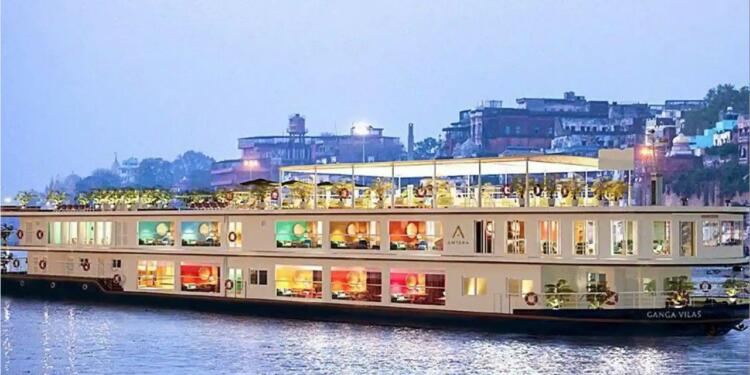MV Ganga Vilas: The West has always exploited and tried to dominate India for its own gain. It is obvious that the exploitation of India’s resources has caused a great deal of suffering and has held back the country’s progress for decades. Thankfully, Dr. S. Jaishankar is now working to bring these facts to light and ensure India is able to pursue its own developmental goals.
But now, when Dr. Jaishankar is working to make sure India has the freedom and ability to develop independently, without the interference of the West, he is actively speaking out about the need for a fairer, more equitable relationship between India and the West.
The West doesn’t seem to be pleased with India’s independent actions; however, due to India’s growing prominence on the international stage, they can no longer impede on India’s interests as they have done in the past. All they can do is offer their criticism, which is not even constructive.
“The Guardian” need some Parenting
Recently, a hypocritical newspaper expressed its concern over the state of marine life in the Ganges River. This is a commendable gesture, as it shows an awareness of the plight of the environment and its inhabitants.
Well, it is important to ensure that the concern is well-informed and unbiased. However, biassed views can often be a sign of limited understanding, and that is the case when it comes to foreign media who are lecturing India over the pollution of the Ganga River.
Also read: PM Modi receives first container vessel on Inland Waterways
The journalists of The Guardian and New York Times who have written this article may be sitting on a cruise in America or London. Western countries that use waterways for business and tourism in the smallest of canals are now telling India that the only cruise in India will affect the lives of dolphins.
Author Anish Gokhale, while exposing the hypocrisy of western countries, said in a tweet that western countries need to take care of the environment. First of all, they should not give knowledge about waterways to India.
He opened the whole mystery by asking, “Since when did different types of ships start operating on waterways, from cruise ships to boats?” Anish also stated that countries that have brought about a significant revolution in tourism through waterways now find India’s project of development in water tourism difficult to digest.
While environmental concerns should be addressed, buddhi jeevis should not be allowed to hijack India's Inland Water Transport and destroy it.
We are already behind the whole world. pic.twitter.com/hmMoyREC3V
— Aneesh Gokhale (@authorAneesh) January 15, 2023
There is a 600-kilometer waterway between the Atlantic Ocean and Lake Superior. It is called the Canada-USA St. Lawrence Seaway. This route is used by cruise ships and ships taller than 170 meters. The 200-meter ships that ply this route deliver goods to the Midwest of America.
Apart from this, in 1895, Germany cut the Kiel Canal from northern Germany to reduce the distance of 200 miles to Denmark; now about 30,000 sea vessels pass through this 100-kilometer-long waterway every year.
Apart from this, in China, about 1000 tonnes of cargo pass from Shanghai to Chongqing on the Yangtze River, which is 1700 kilometres long. In 1869, the Suez Canal was built, which halved the distance between India and Europe.
This canal was opened, and a commercial revolution was seen in a few decades, but during that time India was a slave and all the work was done by western countries, so everything was considered right and justified. Recently, a 90-metre-long ship was launched on India’s largest river, the Brahmaputra, for transport.
However, there are strict laws around the world to protect the marine environment. You cannot throw food into the water in any river. Apart from this, there are laws to control emissions and speed restrictions to preserve marine life, but how much these laws have been respected by the West is the biggest question in itself.
Also read: Maldives ought to understand that its high time to join hands with India or perish
Old tactic of Urban Naxal on MV Ganga Vilas
This is not the first instance in which India has encountered these issues. It is now clear to everyone how our devious neighbours have manipulated innocent people from tribal regions to advance their plot against India’s progress.
Whether discussing a nuclear power plant, bridge, or port, there have always been protests from so-called activists against the government. Sometimes in the name of the environment, sometimes in the name of the villagers’ lives. These protests, often led by urban Naxalites, have been used to oppose the government’s initiatives and attempt to stop the progress of such projects.
India has been dealing with these issues for a long time and is confident in its approach. To further promote water tourism, India plans to increase the number of boats and cruises by 10 times.
Also read: Project 17A: Indian Navy’s ambitious project that will fortify its dominance in the sea
However, Kashif Siddiqui, Marketing Director of Antara Cruises, said the MV Ganga Vilas cruise was so popular that trips were sold out for the next two years. “We are following all the environmental precautions and government guidelines,” he said. Promotional material for the cruise says: “With sustainable principles at its heart, the MV Ganga Vilas incorporates pollution prevention and noise control technologies to honour the ancient rivers travelled through.”
In such a situation, the West’s objectionable comment on the operation of cruises in India shows that if waterways are used in this way in India, economic development will happen more rapidly, which is not being seen in western countries now, so they keep on doing the drama of jealousy.
Support TFI:
Support us to strengthen the ‘Right’ ideology of cultural nationalism by purchasing the best quality garments from TFI-STORE.COM































